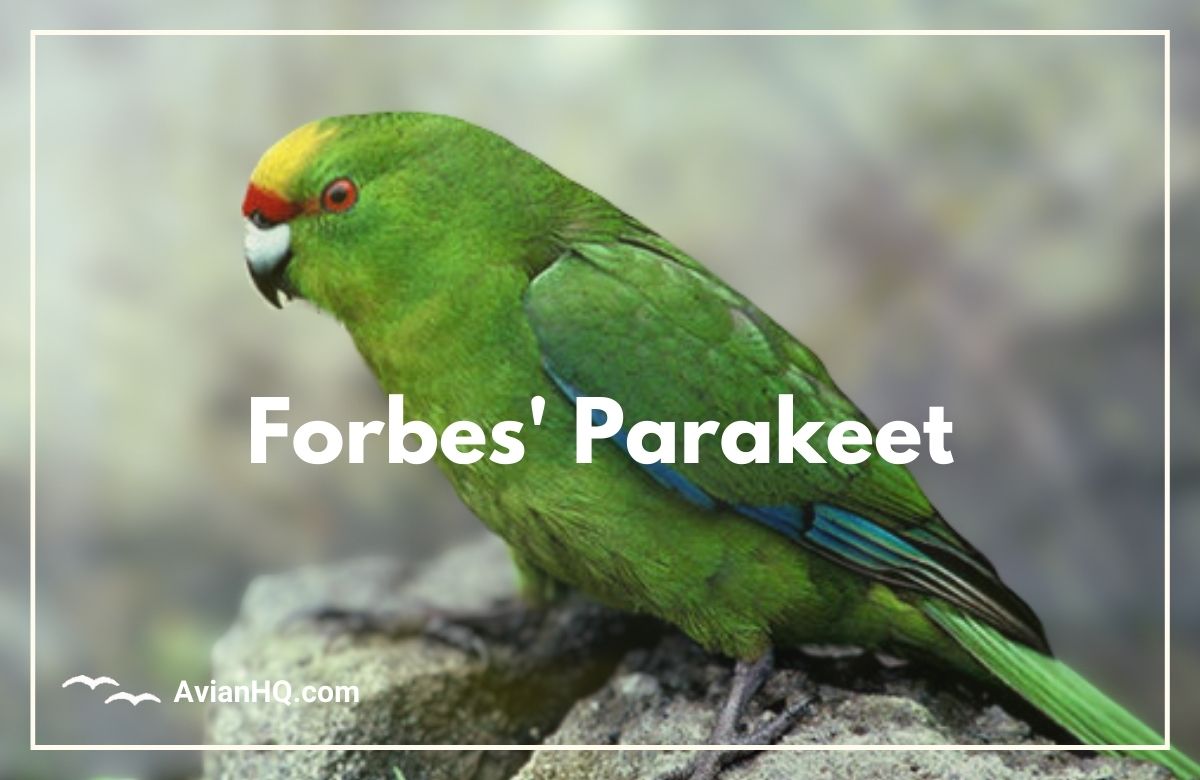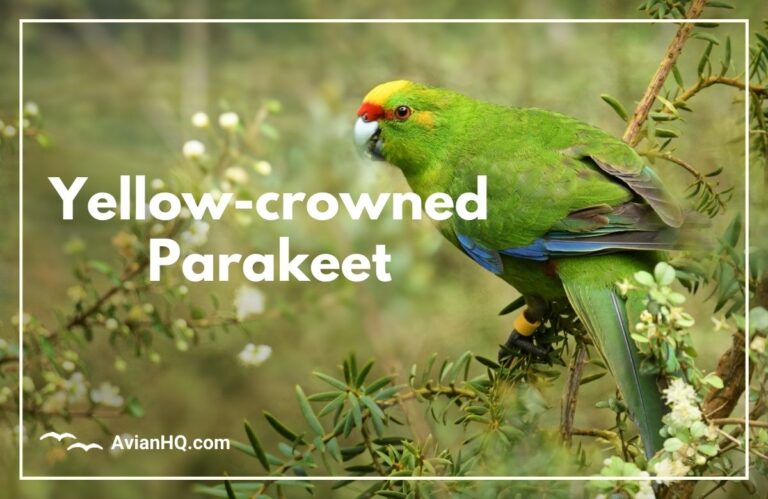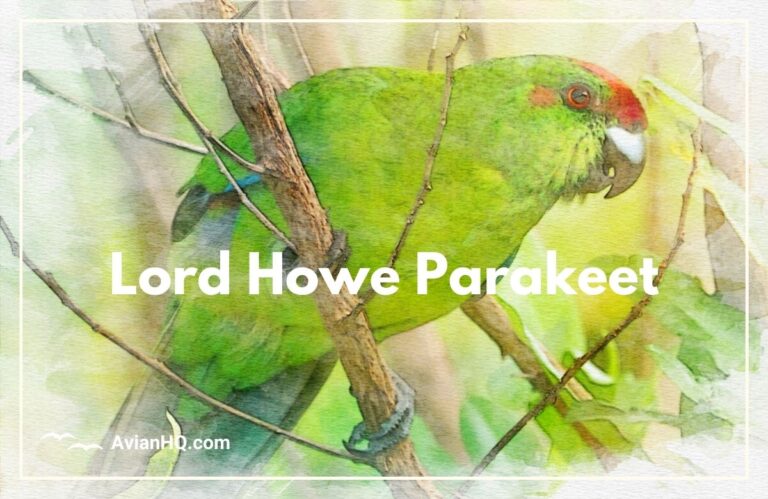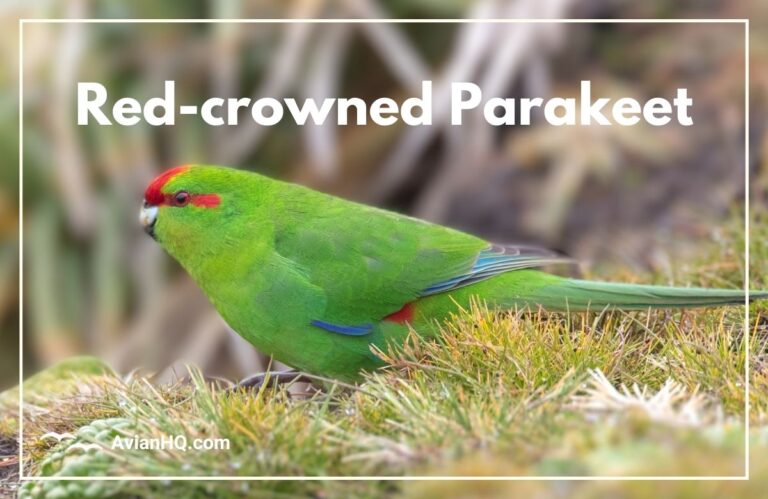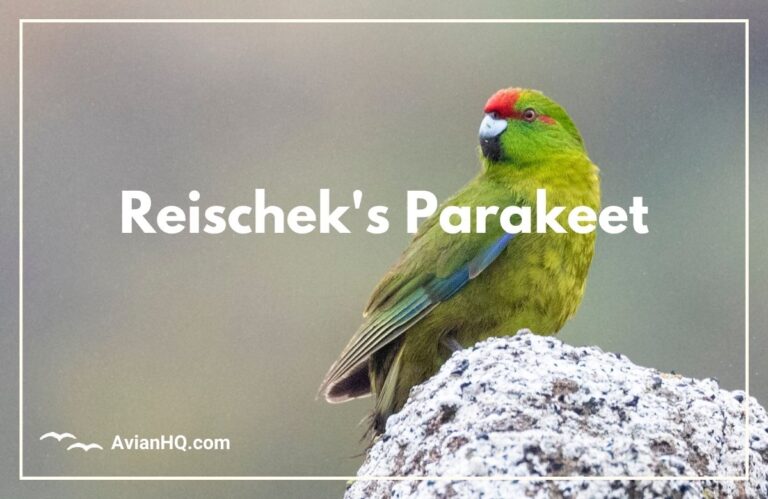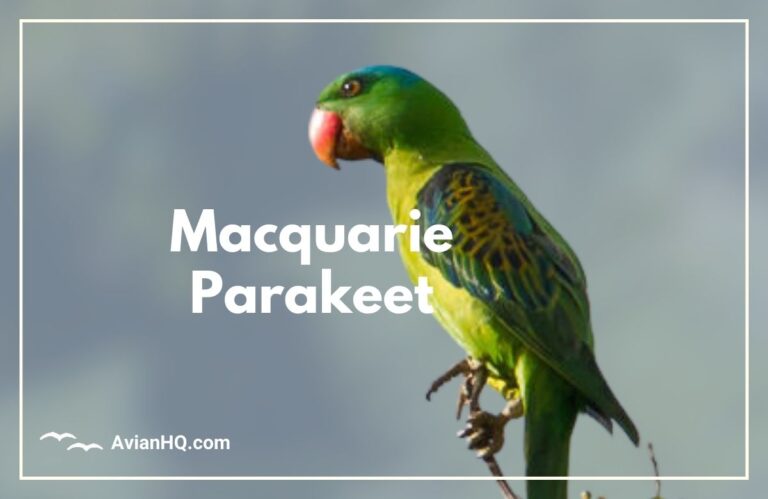Forbes’ Parakeet (Cyanoramphus forbesi)
Have you ever seen a bright green parakeet with an orange face? If you were in New Zealand, it may have been the rare Forbes’ Parakeet. This unique bird only lives on one tiny island chain far out in the Pacific Ocean.
The Forbes’ Parakeet (Cyanoramphus forbesi) is medium-sized parrot that grows to about 9 inches (23 cm) long. Its feathers are mostly bright green, with a blue patch on the wings. But its most striking feature is the adult male’s bright orange face and forehead.
“The male’s orange face seems to glow like a sunrise against the green plumage.”
The species was named after the British ornithologist Henry Ogg Forbes who discovered it in the 1800s. Tragically, these little parakeets came close to vanishing forever over the past century. Predators, habitat loss, and competition from invasive species nearly wiped them out. By 1970, only about 50 Forbes’ Parakeets remained in the wild.
Conservationists jumped into action to try and bring the species back from the brink. Through captive breeding and release programs, the Forbes’ Parakeet population has rebounded to over 200 birds today. But they still remain critically endangered.
You’ll learn more about what makes this parakeet so special and why protecting rare birds like it matters. This comprehensive guide will cover everything from the Forbes’ Parakeet’s evolutionary past, physical appearance, habitats, behaviors, and current conservation efforts. Let’s get started!
History and Taxonomy
The Forbes’ Parakeet has a relatively short scientific history compared to some other parrot species. Most parrots were described back in the 1700s and 1800s when early naturalists first encountered them.
Henry Ogg Forbes first scientifically documented the Forbes’ Parakeet in 1882 during his ornithological expeditions around New Zealand’s remote offshore islands. He named the new parakeet species Cyanoramphus auriceps forbesi in honor of his father.
Since then, there have been some minor taxonomic changes:
- 1921: The species was reclassified as a subspecies called Cyanoramphus novaezelandiae forbesi.
- 1987: Elevated back to full species status as Cyanoramphus forbesi.
So Forbes’ initial designation of the orange-fronted parakeet stands today as the distinct Forbes’ Parakeet species. Its closest genetic relative is actually the larger Red-crowned Parakeet of mainland New Zealand.
Physical Appearance
The Forbes’ Parakeet is a colorful medium-sized parrot measuring about 9 inches (23 cm) from head to tail.
Size and Proportions
- Length: 9 inches (23 cm)
- Wingspan: 13 inches (33 cm)
- Weight: 1.5-2 ounces (40-55 grams)
The body shape is typical of parakeets with a stocky body, short tail, bent peak-shaped bill, and long pointed wings.
Plumage
- Mostly bright green feathers on the back, wings, tail, thighs, and undersides
- Blue patches on the leading edges of the wings
- Distinctive bright orange-red band across the forecrown and above the beak (restricted to adult males)
- Females have green where males have orange facial feathers
- Fledglings have dark beaks that turn orange when mature
The green and blue shades vary from dull to bright among individuals. The male’s striking “fire crown” makes the Forbes’ Parakeet one of the most colorful parakeets.
Legs and Feet
Like all parrots, the Forbes’ Parakeet has zygodactyl feet – two toes face forward and two face backwards for superior perching grip. Their feet and grey-black legs are about 1 inch long.
Differences Between Males and Females
- Males have bright orange feathers on the forehead, face, and above the beak
- Females lack orange feathers, retaining green feathers instead like the body
- Females may have slightly less vibrant green and blue shades
So the male’s distinct orange facial profile makes sexing Forbes’ Parakeets quite easy.
Habitat and Distribution
The Forbes’ Parakeet is endemic to New Zealand’s remote Chatham Islands archipelago located about 500 miles east of the mainland. Specifically, it inhabits Mangere and Rangatira Islands which have a combined land area of only about 12 square miles.
Native Range
- Restricted to forest and scrubland habitats on Mangere and Rangatira Islands
- Also formerly found on nearby Pitt Island before extinction there
- Total world population confined to the tiny Chatham Islands
Geographic Isolation
Long geographic isolation allowed the Forbes’ Parakeet to evolve differently from mainland New Zealand parakeets. Today it persists in the island refuge that once nearly became its prison.
The Chatham Islands host a range of habitat zones that the parakeets occupy:
- coastal forest
- scrubland
- swamps
- plantations
However, they seem to prefer areas with mature trees for nesting and feeding. Protecting these forest ecosystems is crucial to preserving the last wild populations.
Introduced Foreign Populations
Thanks to conservation efforts in recent decades, the parakeets now inhabit additional nature reserves outside their native islands including:
- Motuora Island
- Long Island Nature Reserve
- Wellington Zoo sanctuary
These new sanctuary locations help buffer the Forbes’ Parakeet from unexpected disaster on its only natural home in the Chathams.
Diet and Feeding
The Forbes’ Parakeet enjoys a diverse herbivorous diet consisting of seeds, fruits, berries, blossoms, and vegetation procured across its forest and scrubland habitats.
Primary Foods
- Seeds and nuts from trees and shrubs
- Fruits like tawa, karaka, kotukutuku
- Nectar and pollen from flowers
- Leaf buds, bark, and other plant matter
Their strong curved beaks allow them to crack into seeds and nuts. A muscular tongue helps manipulate food inside the mouth.
Feeding Patterns
The parakeets feed opportunistically on seasonal foods:
- Autumn and winter – more seeds and nuts
- Spring and summer – more fruits and flowers
They typically feed in the high forest canopy but will come to lower levels as needed. Forbes’ Parakeets appear somewhat less social than some related species while foraging.
Daily Intake
On average, the wild parakeets eat about 1-2 ounces (30-60 grams) of food a day. That’s equivalent to roughly 5-10% of their total body weight. Captive parakeets fed high quality diets only need about half as much daily.
Providing the right balance of seed and produce helps maintain healthy Forbes’ Parakeet populations. Provisioning food sources has boosted recovery efforts when wild supplies are scarce.
Breeding and Reproduction
The breeding season for Forbes’ Parakeets runs from November through February yearly. During this time they form monogamous breeding pairs and prepare nests.
Age of Sexual Maturity
- Reach maturity for mating at 18 months old
- May start attempting to breed as early as 6 months old
- Normally first breed at 2 to 5 years old
Breeding Season
- Late spring to summer (November – February)
- Nest building starts in November
- Egg laying peak is December/January
Nest Sites
The parakeets nest high in the forest canopy or scrublands. Favorite nest locations include:
- Tree hollows and cavities
- Crevices in trunks or branches
- Old stick nests built by other birds
Both the male and female contribute to nest preparation with the female doing most of the incubating duty.
Number of Eggs
- 4-6 white eggs per clutch
- Up to 8 eggs rarely documented
- Replacement clutches possible if first fails
The future of the Forbes’ Parakeet depends on successful reproduction each season. Helping provide suitable nesting resources can give a boost to wild numbers.
Behavior and Ecology
The Forbes’ Parakeet exhibits some typical parrot behaviors but also shows some unique adaptations to its island environment. Understanding how they interact and respond provides insights into supporting the remaining populations.
Daily and Seasonal Cycles
- Most active in early mornings and late afternoons
- Short bursts of activity spaced by resting periods
- Increased vocalizations and activity just before breeding season
- Travel greater distances when food becomes scarcer
Vocalizations
Their frequent high-pitched calls pierce the forest canopy. Some common vocalizations include:
- Rapid chatters when interacting in groups
- Loud contact calls between mates
- Begging calls from younger birds
Social Structure
Unlike other parakeet species that travel in large flocks, the Forbes’ Parakeet is somewhat asocial by comparison. Small groups of a dozen or less birds associate for feeding and breeding activities.
Interactions with Other Species
- Competition for food and nesting with calls ducks
- Attacked by harriers if caught out in open areas
- Target of bullies mela by introduced species
Understanding species interactions helps promote habitats where endemic birds get priority over invasives. Safeguarding fragile island ecosystems can prevent extinctions.
Conservation Status
The Forbes’ Parakeet has teetered dangerously close to extinction over the past century. Its populations crashed from over 1,200 birds in 1920 down to only 50 individuals by 1970 from habitat loss and invasive predators. Intensive recent conservation efforts have helped the species begin to recover, but its outlook remains precarious.
Formal Conservation Status
- IUCN Red List: Endangered
- New Zealand: Nationally Critical
Both assessments indicate dangerously low population sizes putting the Forbes’ Parakeet at risk of extinction.
Population Size and Trends
- 1920s population estimated over 1,200 birds
- Declined to only 50 birds by 1970
- Current total wild population is 200-300
- Captive reserve populations number over 150
Threats
- Habitat destruction from deforestation and farming
- Predation from invasive species like rats and cats
- Competition for resources from other birds
- Stochastic disasters like storms or disease
Conservation Efforts
- Legal protected status since 1891
- Predator control and habitat restoration
- Captive breeding and release programs
- Supplementary feeding when wild foods are scarce
Vigilant ongoing conservation management gives the Forbes’ Parakeet hope. But until it reaches larger sustainable numbers, its future hangs by the slimmest of threads.
Cultural Significance
The Forbes’ Parakeet has limited cultural significance due to its remote island location and small population size. But it has become an icon for New Zealand conservation and ecosystem preservation.
Indigenous Notability
There is no evidence the small endemic bird played any role in the traditional culture of the Chatham Island Moriori or mainland Maori people. Any past cultural associations were likely lost when invasive species decimated the parakeet population.
Art and Media Representation
More recently, the striking orange and green Forbes’ Parakeet has been depicted in artwork and featured in some children’s books about New Zealand’s rare birds. As public knowledge grows, so too have artistic tributes to this species on the brink.
Tourism Appeal
Ecotourism charters now offer rare birdwatching excursions to see the Forbes’ Parakeet and other Chatham Island endemics in their natural habitat. Strict access controls prevent disturbance to these sensitive sites.
Symbol of Conservation
Back from just 50 birds remaining in 1970, the Forbes’ Parakeet epitomizes successful species recovery via intensive management. It reminds us that even when critically endangered, there still can be hope through tireless dedication.
Conclusion
The rare and beautiful Forbes’ Parakeet remains one of New Zealand’s most threatened endemic bird species. We came heartbreakingly close to losing its bright plumes and cheery calls forever.
Thanks to Herculean conservation efforts over the past 50 years, the beloved Forbes’ Parakeet was snatched back from the brink at the 11th hour. The population now numbers some 200 individuals in the wild and 150 birds in captive backup colonies.
Yet the species still balances precariously on the knife’s edge of extinction. One severe storm, the introduction of a new predator, or outbreak of disease could rapidly undo decades of work. Continued habitat restoration and management remain essential to hopes of rereleasing captive parakeets back to an environment where they can thrive.
The Forbes’ Parakeet is a poignant reminder of the fragility of island ecosystems. This small parrot warns us of the conservation challenges ahead as climate change and other threats put increasing pressure on endangered species worldwide. But it also symbolizes that diligent environmental stewardship can achieve remarkable rehabilitation results.
This guide covered the Forbes’ Parakeet’s identifying features, habitats, behaviors, threats, and the ongoing efforts to preserve it. We all have a responsibility now to ensure this rare endemic bird regains a secure foothold for generations to come. Support critical habitat conservation projects across the globe, be an ethical ecotourist, and spread awareness about how fragile biodiversity can rebound if given the chance.
The fiery orange crown of the Forbes’ Parakeet must never fade from New Zealand’s forests. This tenacious bird demonstrates that where there is sufficient passion and dedication, we can reverse environmental degradation, halt extinctions, and allow life to flourish again.

